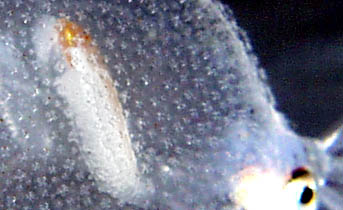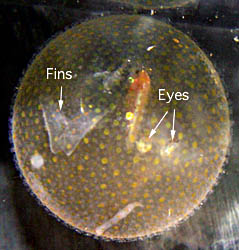Cranchia
Cranchia scabra
Richard E. Young and Katharina M. Mangold (1922-2003)Introduction
C. scabra, the only species in the genus, is small (150 mm ML) and one of the most distinctive cranchiids. The mantle is covered by large, multi-pointed cartilagenous tubercles (see Roper and Lu 1990, for a description of the tubercle structure). When disturbed, the squid often pulls its head and arms into the mantle cavity and folds its fins tightly against the mantle to form a turgid ball. The tubercules, presumably, provide some type of protection but it is unclear what predators are affected and how. In addition, the squid may ink into the mantle cavity, making the ball opaque. This was thought to be an aberrant behavior due to stress and confinement of shipboard aquaria until the same inking behavior was seen in cranchiids from submersibles (Hunt, 1996). The function of this behavior is unknown
Diagnosis
A cranchiin ...
- with mantle covered with cartilagenous tubercules.
Characteristics


Figure. Lateral view of part of the mantle and head of a 30 mm ML C. scabra showing tubercles. Photograph by R. Young.
- Tentacles
- Tentacular club with suckers only.
- Diagonally set pairs of suckers and pad on distal 2/3 of tentacular stalk.
- Head
- Eyes sessile in paralarvae.
- Funnel
- Funnel valve present, large.
- Mantle
- Mantle covered with cartilagenous tubercles bearing 3-5 sharp cusps.
- Fins
- Each fin nearly oval in shape with free posterior lobes.
- Photophores
- Fourteen oval photophores on each eye.
- Photophores on tips of all arms in mature or nearly mature females.
Comments
Characteristics are from Voss (1980). More details of the description of C. scabra can be found here.
Behavior
The small C. scabra below, photographed in a shipboard aquarium, has retracted its head with arms and tentacles into the mantle cavity. The mantle has taken the shape of a sphere and the chromatophores have expanded. This response to disturbance presumably makes their consumption by small-mouthed predators more difficult.


Figure. Posterolateral view of C. scabra, 30 mm ML. Photograph by R. Young.
The photographs below, also taken in an aquarium, show two different color phases of the same squid. A typical transparent phase on the right and a peculiar anteriorly pigmented phase on the left. The half-pigmented phase was seen several times (D. Fenolio, pers. communication).


Figure. Two side views of the same C. scabra, Sea of Japan, ca. 10 cm ML. Photographs by Danté Fenolio.
Life History
Small paralarvae lack tubercles and are similar in appearance to paralarvae of Liocranchia.Liocranchia However they can easily be separated from members of by the numerous chromatophores that cover much of the mantle (drawings on the left) and that soon cover the entire mantle. Note the sessile eyes. By 8 mm ML they have numerous tubercules (drawing on the right).



Figure. Paralarval C. scabra. Left - Ventral and dorsal views, 4.7 mm ML, Hawaiian waters. Drawings by R. Young. Right - Ventral view, 8 mm ML. Drawing from Voss, 1980, p. 377, printed with the permission of the Bulletin of Marine Science. Scale bar is 1 mm.
Distribution
This species occurs throughout tropical and subtropical waters of the world's oceans (Nesis, 1982).
References
Hunt, J. 1996. The behavior and ecology of midwater cephalopods from Monterey Bay: Submersible and laboratory observations. Doctoral Diss., Univ. Calif. Los Angeles.
Roper, C. F. E. and C. C. Lu 1990. Comparative morphology and function of dermal structures in oceanic squids (Cephalopoda). Smithson. Contr. Zool., No. 493: 1-40.
Young, R. E. 1972. The systematics and areal distribution of pelagic cephalopods from the seas off Southern California. Smithson. Contr. Zool., 97: 1-159.
Title Illustrations

| Scientific Name | Cranchia scabra |
|---|---|
| Comments | photographed in a shipboard aquarium off Hawaii. |
| Size | 30 mm ML |
| Copyright |
© 1998 Richard E. Young

|
About This Page
Richard E. Young

University of Hawaii, Honolulu, HI, USA
Katharina M. Mangold (1922-2003)

Laboratoire Arago, Banyuls-Sur-Mer, France
Page copyright © 1998 Richard E. Young and Katharina M. Mangold (1922-2003)
- Content changed 14 June 2007
Citing this page:
Young, Richard E. and Mangold (1922-2003), Katharina M. 2007. Cranchia . Cranchia scabra . Version 14 June 2007. http://tolweb.org/Cranchia_scabra/19542/2007.06.14 in The Tree of Life Web Project, http://tolweb.org/








 Go to quick links
Go to quick search
Go to navigation for this section of the ToL site
Go to detailed links for the ToL site
Go to quick links
Go to quick search
Go to navigation for this section of the ToL site
Go to detailed links for the ToL site